The latest issue of Analyst is now available for you to browse, and we head east for all three covers.
There’s nanoparticle-assisted laser desorption/ionisation MS from Japan, electrochemical biosensing from Korea, and microextraction from Taiwan.
The latest issue of Analyst is now available for you to browse, and we head east for all three covers.
There’s nanoparticle-assisted laser desorption/ionisation MS from Japan, electrochemical biosensing from Korea, and microextraction from Taiwan.
 FACSS in conjunction with JPAG, RSC MSG & the IRDG present a Joint Symposium
FACSS in conjunction with JPAG, RSC MSG & the IRDG present a Joint Symposium
on “Advances in Raman Spectroscopy in Pharmaceutical Analysis” on 17 May 2012: London, UK.
Registration is now open!
Jointly organised with: Federation of Analytical Chemistry and Spectroscopy Societies (FACSS), the Joint Pharmaceutical Analysis Group (JPAG), the Royal Society of Chemistry Molecular Spectroscopy Group (MSG) and the Infrared & Raman Discussion Group (IRDG).
Raman spectroscopy has found favor in pharmaceutical analysis because it is nondestructive, requires minimal sample preparation, and gives clear spectra for identification. This 1-day symposium demonstrates a breadth of successful Raman applications spanning the R&D field, API development, scale-up, and manufacturing, as well as drug product formulation development, characterization, and product assay. Poster presentations, a student prize, and an exhibition of Raman instruments add to the value of the symposium.
Additional information about this symposium is available here.
This meeting represents one of the first “FACSS present” events. FACSS participation in this meeting is in support of several of the member organizations of FACSS and the charter of FACSS.
Programme topics include:
• The use of Raman in characterising amorphous and crystalline forms of APIs
• Moving PAT from laboratory to production and getting FDA approval
• Raman spectral imaging to characterise individual particles
• Removing the effects of packaging to identify raw materials with Spatially Offset Raman Spectroscopy [SORS]
• Reverse engineering studies with Raman imaging to defend patents
• Why transmission Raman spectroscopy is the future: case studies
• Comparison of NIR, Raman backscattering and transmission spectroscopy for the analysis of polymorphs
• Laboratory vs hand-held instruments: what you gain and what you lose
• Vendors’ showcase exhibition
In this HOT review paper, Richard Compton and co-workers from Oxford University discuss the importance of glutathione determination, which has been shown to have physiological importance in diseases such as Parkinson’s, diabetes and cancer. Because of its medical significance, it is important to have quick and easy assays to aid clinical diagnostics and treatment. Click here to read more!
Electrochemical determination of glutathione: a review
John C. Harfield, Christopher Batchelor-McAuley and Richard G. Compton
Analyst, 2012, Advance Article
DOI: 10.1039/C2AN35090D
In this HOT paper Seetharaman Vaidyanathan and colleagues from the University of Sheffield explore a new method for screening metabolites based on an array format, using relative polarity and selective solvent dissolution. This approach has the potential to be a successful way of rapidly screening metabolomes and it will allow the simultaneous screening and profiling of multiple samples.
A solvation-based screening approach for metabolite arrays
Malinda Salim, Phillip C. Wright and Seetharaman Vaidyanathan
Analyst, 2012, Advance Article
DOI: 10.1039/C2AN16318G
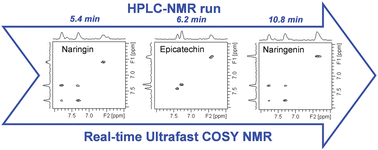
Real-time separation of natural products by ultrafast 2D NMR coupled to on-line HPLC
Luiz H. K. Queiroz Júnior, Darlene P. K. Queiroz, Liene Dhooghe, Antonio G. Ferreira and Patrick Giraudeau
Analyst, 2012, Advance Article
DOI: 10.1039/C2AN16208C
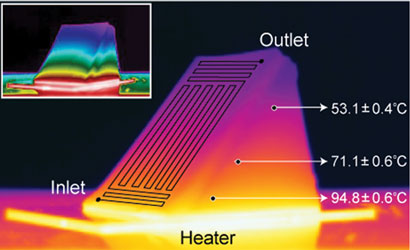
A height-dependent linear temperature gradient established on the inclined surface of a 3D qiandu (right triangular prism)-shaped PDMS microdevice enables flow-through PCR employing a single heater
South Korean scientists have created a temperature cycle for the on-chip flow-through polymerase chain reaction (PCR) using a single heater.
PCR is used to make copies of a piece of DNA for genetic research, disease analysis and diagnosis. It consists of four main steps – initialisation; denaturation (melting the DNA template to yield single-stranded DNA); annealing primers to the single-stranded DNA template; and extension, in which the DNA polymerase synthesises a new DNA strand complementary to the DNA template.
On-chip flow-through PCR typically has a short reaction time due to rapid thermal equilibrium allowing quick temperature transitions; however, it normally requires several separate heating blocks to create the different temperatures. Reducing the number of heaters will help make the whole system smaller and more portable. ‘Analysing samples on site could help prevent degradation and contamination,’ explains Nae Yoon Lee from Gachon University, South Korea, who led the research.
Read the full story here in Chemistry World.
Link to journal article:
Flow-through PCR on a 3D qiandu-shaped polydimethylsiloxane (PDMS) microdevice employing a single heater: toward microscale multiplex PCR
Wenming Wu, Kieu The Loan Trinh and Nae Yoon Lee
Analyst, 2012, Advance Article
DOI: 10.1039/C2AN35077G
It’s been a busy year already with so many great papers, so here are some HOT articles from Analyst that you might have missed this month!
Why not take a look, they will be free to read for 2 weeks.
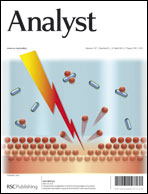 A hydrophobic entrance enhances ion current rectification and induces dewetting in asymmetric nanopores
A hydrophobic entrance enhances ion current rectification and induces dewetting in asymmetric nanopores
Matthew Pevarnik, Ken Healy, Matthew Davenport, Joseph Yen and Zuzanna S. Siwya
Analyst, 2012, Advance Article
DOI: 10.1039/C2AN16139G
Analytical investigation of salivary calculi, by mid-infrared spectroscopy
Jean-François Sabot, Marie-Paule Gustin, Katia Delahougue, Frédéric Faure, Christelle Machon and Daniel-Jean Hartmann
Analyst, 2012, Advance Article
DOI: 10.1039/C2AN15924D
Metal-based impurities in graphenes: application for electroanalysis
Sze Yin Chee and Martin Pumera
Analyst, 2012, Advance Article
DOI: 10.1039/C2AN00022A
Integration of gas chromatography mass spectrometry methods for differentiating ricin preparation methods
David S. Wunschel, Angela M. Melville, Christopher J. Ehrhardt, Heather A. Colburn, Kristin D. Victry, Kathryn C. Antolick, Jon H. Wahl and Karen L. Wahl
Analyst, 2012, Advance Article
DOI: 10.1039/C2AN16186A
A novel method for simultaneous analysis of three β2-agonists in foods with the use of a gold-nanoparticle modified glassy carbon electrode and chemometrics
Xiaoyun Lin, Yongnian Ni, Shuzhen Li and Serge Kokot
Analyst, 2012, Advance Article
DOI: 10.1039/C2AN16062E
Flow-through PCR on a 3D qiandu-shaped polydimethylsiloxane (PDMS) microdevice employing a single heater: toward microscale multiplex PCR
Wenming Wu, Kieu The Loan Trinh and Nae Yoon Lee
Analyst, 2012, Advance Article
DOI: 10.1039/C2AN35077G
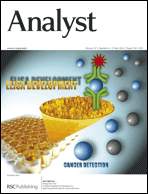 Electrochemiluminescent detection of Mucin 1 protein and MCF-7 cancer cells based on the resonance energy transfer
Electrochemiluminescent detection of Mucin 1 protein and MCF-7 cancer cells based on the resonance energy transfer
W. Wei, D. F. Li, X. H. Pan and S. Q. Liu
Analyst, 2012, Advance Article
DOI: 10.1039/C2AN35059A
Enhanced fluorescent chemosensor for Ag+ in absolute aqueous solution and living cells: An experimental and theoretical study
Mingming Hu, Jiangli Fan, Jianfang Cao, Kedong Song, Hua Zhang, Shiguo Sun and Xiaojun Peng
Analyst, 2012, Advance Article
DOI: 10.1039/C2AN16272E
Ultrasensitive electrochemiluminescence immunosensor using PtAg@carbon nanocrystals composites as labels and carbon nanotubes-chitosan/gold nanoparticles as enhancer
Meng Zhang, Weijian Dai, Mei Yan, Shenguang Ge, Jinghua Yu, Xianrang Song and Wei Xu
Analyst, 2012, Advance Article
DOI: 10.1039/C2AN35186B
A new continuous fluorometric assay for acetylcholinesterase activity and inhibitor screening with emissive core–shell silica particles containing tetraphenylethylene fluorophore
Xiang Shen, Fuxin Liang, Guanxin Zhang and Deqing Zhang
Analyst, 2012, Advance Article
DOI: 10.1039/C2AN35154D
Examining changes in cellular communication in neuroendocrine cells after noble metal nanoparticle exposure
Sara A. Love, Zhen Liu and Christy L. Haynes
Analyst, 2012, Advance Article
DOI: 10.1039/C2AN00034B
Noise Adjusted Principal Component reconstruction to optimize infrared microspectroscopy of individual live cells
Ellen J. (Swain) Marcsisin, Christina M. Uttero, Antonella I. Mazur, Miloš Miljković, Benjamin Bird and Max Diem
Analyst, 2012, Advance Article
DOI: 10.1039/C2AN15868J
Graphene oxide integrated sensor for electrochemical monitoring of mitomycin C–DNA interaction
Arzum Erdem, Mihrican Muti, Pagona Papakonstantinou, Ece Canavar, Hakan Karadeniz, Gulsah Congur and Surbhi Sharma
Analyst, 2012, Advance Article
DOI: 10.1039/C2AN16011K
Expression of membrane-associated proteins within single emulsion cell fascimiles
Mayuree Chanasakulniyom, Chiara Martino, David Paterson, Louise Horsfall, Susan Rosser and Jonathan M. Cooper
Analyst, 2012, Advance Article
DOI: 10.1039/C2AN35047E
A highly selective and sensitive enzyme-linked immunosorbent assay (ELISA) for the determination of the synthetic dye Para red in foodstuffs has been developed by Ting Xu, from the China Agriculture University, and colleagues. Para red is a dye that is used in printing, and is prohibited in foodstuffs due to it being a potential genotoxic carcinogen. The assay was tested on real food, and was comparable to current methods which are more resource intensive.
A sensitive and selective enzyme-linked immunosorbent assay for the analysis of para red in foods
Jia Wang, Keyi Wei, Hao Li, Qing X. Li, Ji Li and Ting Xu
Analyst , 2012, Advance Article
DOI : 10.1039/C2AN35127G
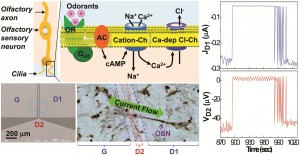 Youngkyoo Kim from the Kyungpook National University, Republic of Korea, and colleagues have developed an artificial nose that can mimic the real thing! Olfactory sensory neurons from rats were cultured onto indium-tin oxide electrodes and direct voltage and current signals were then measured when it was exposed to odorants. It is hoped the present system can help advance the work in biomimetic artificial noses, which have a number of applications in medical diagnosis, anti-bioterror devices and environmental monitoring.
Youngkyoo Kim from the Kyungpook National University, Republic of Korea, and colleagues have developed an artificial nose that can mimic the real thing! Olfactory sensory neurons from rats were cultured onto indium-tin oxide electrodes and direct voltage and current signals were then measured when it was exposed to odorants. It is hoped the present system can help advance the work in biomimetic artificial noses, which have a number of applications in medical diagnosis, anti-bioterror devices and environmental monitoring.
Direct measurement of extracellular electrical signals from mammalian olfactory sensory neurons in planar triode devices
Hwajeong Kim, So Yeun Kim, Sungho Nam, Gabriele V. Ronnett, Hyung Soo Han, Cheil Moon and Youngkyoo Kim
Analyst , 2012, Advance Article
DOI : 10.1039/C2AN16205A
In this HOT article Xiu-Ping Yan and colleagues from Nankai University have developed a colourimetric method to determine the presence of histidine in urine. The method is detectable by the naked-eye, with an obvious colour change from yellow to purple. The detection of histidine, an amino acid found in many proteins, is used to help with the diagnosis of histidine metabolism disorders and other diseases such as epilepsy and Parkinson’s disease.
Take a look at their paper, it will be free to read for 2 weeks.
An indicator-displacement assay for naked-eye detection and quantification of histidine in human urine
Shao-Kai Sun, Kai-Xiong Tu and Xiu-Ping Yan
Analyst, 2012, Advance Article
DOI: 10.1039/C2AN35126A